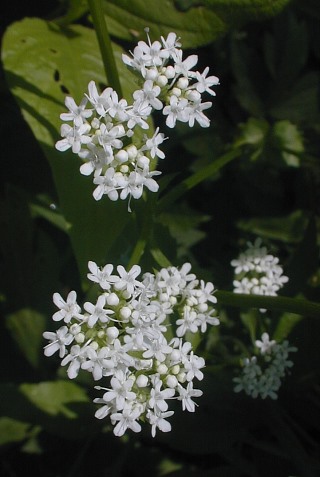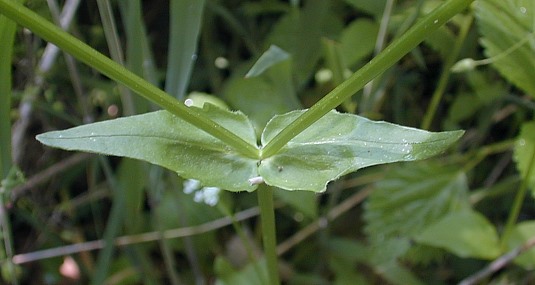Description:
This
wildflower is a winter or spring annual about 1-3' tall.
Initially, a low rosette of basal leaves is formed, but later there
develops an erect central stem that is unbranched below and
dichotomously branched above. The central and upper stems are light
green, terete or angular, and either glabrous or lined with short fine
hairs. The basal leaves are up to 2½" long and ¾" across; they are
medium green, glabrous, oblanceolate, and smooth along their margins.
The cauline leaves (up to 3" long & 1" across) occur in opposite
pairs along the central and upper stems, where they are either sessile
or clasp the stems slightly. The lower cauline leaves are oblong and
smooth along the margins (see Lower
Leaves), while the upper cauline leaves are lanceolate with
lower teeth that are dentate. Like the basal leaves, the cauline leaves
are medium green and glabrous; sometimes they are slightly ciliate
along their margins. The upper stems terminate in flat-headed clusters
(or dense cymes) of white flowers; each cluster spans about ½–1½"
across. There is a pair of small leafy bracts where the stalks of the
inflorescence dichotomously branch; these bracts are lanceolate in
shape. Each flower has a small funnelform corolla with 5 spreading
lobes; this corolla is white and spans about 1/6" (4 mm.) across. At
the base
of the flower, there is a small green calyx with 5 teeth; this calyx is
much shorter than the corolla. Exerted from the corolla, there are 3
stamens and a single style. The blooming period occurs during late
spring to early summer and lasts about 3 weeks. The flowers are very
fragrant. Each flower is replaced by a 3-celled fruit spanning about 3
mm. long and 2 mm. across (size is variable); one cell contains a
single seed, while the remaining cells are empty. An empty cell is
about the same size as the fertile cell; the shape of a 3-celled fruit
is globoid-angular, rather than sharply triangular. This wildflower
occasionally forms loose colonies of plants.
across) occur in opposite
pairs along the central and upper stems, where they are either sessile
or clasp the stems slightly. The lower cauline leaves are oblong and
smooth along the margins (see Lower
Leaves), while the upper cauline leaves are lanceolate with
lower teeth that are dentate. Like the basal leaves, the cauline leaves
are medium green and glabrous; sometimes they are slightly ciliate
along their margins. The upper stems terminate in flat-headed clusters
(or dense cymes) of white flowers; each cluster spans about ½–1½"
across. There is a pair of small leafy bracts where the stalks of the
inflorescence dichotomously branch; these bracts are lanceolate in
shape. Each flower has a small funnelform corolla with 5 spreading
lobes; this corolla is white and spans about 1/6" (4 mm.) across. At
the base
of the flower, there is a small green calyx with 5 teeth; this calyx is
much shorter than the corolla. Exerted from the corolla, there are 3
stamens and a single style. The blooming period occurs during late
spring to early summer and lasts about 3 weeks. The flowers are very
fragrant. Each flower is replaced by a 3-celled fruit spanning about 3
mm. long and 2 mm. across (size is variable); one cell contains a
single seed, while the remaining cells are empty. An empty cell is
about the same size as the fertile cell; the shape of a 3-celled fruit
is globoid-angular, rather than sharply triangular. This wildflower
occasionally forms loose colonies of plants.
Cultivation:
The preference is partial sun or dappled sunlight, consistently moist
conditions, and soil containing organic matter along with some sand or
rocky material. Most growth and development occurs during the spring.
The seed can remain viable in the ground for about 5 years.
Range & Habitat:
Northern Corn Salad is rare in Illinois, occurring in three NE counties
and two counties in the southern half of the state (see Distribution
Map). It is native and state-listed as 'endangered.' This
species is
slightly more common in Indiana. Habitats include bottomland meadows in
sandstone canyons, springs at the base of cliffs, rocky banks along
woodland streams, and sandy slopes in wooded areas. In Illinois, this
species is found in high quality natural areas, although it has been
found in fields, roadsides, and other disturbed habitats in other
states.
Faunal Associations:
Little is known about floral-faunal relationships for this species. The
nectar of the flowers probably attracts bees and occasional
butterflies. The foliage of Valerianella spp. is
readily eaten by cattle and probably other mammalian herbivores. The
European species, Valerianella locusta (Māche,
Lamb's Lettuce), is cultivated as a source of salad greens for humans;
it has blue flowers.

Photographic
Location:
A bottomland meadow in a sandstone canyon at the Portland Arch in
west-central Indiana.
Comments:
This is one of the more attractive Valerianella spp.
because its flowers are larger than average in size and they are very
fragrant. This is also one of the taller species in this genus. Another
species with similar-sized flowers, Valerianella
chenopodifolia (Great Lakes Corn Salad), differs by having
fruits that are sharply triangular in cross-section; like Northern Corn
Salad, it is quite rare in Illinois. Authorities differ on how the
variations of Northern Corn Salad should be classified. Mohlenbrock
(2002) divides Northern Corn Salad into three different species: Valerianella
intermedia, Valerianella patellaria, and Valerianella
umbilicata. This tripartite division is based on minute
variations in the size and shape of the fruits. Other authors
(Yatskievych, 2000; Kartez, 1994) consider such variations
insignificant and recognize only Valerianella umbilicata
as a valid species. Another common name of Valerianella
umbilicata is Navel-Fruited Corn Salad.